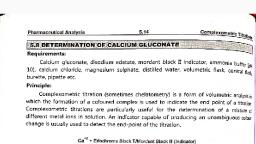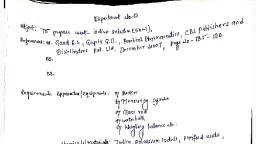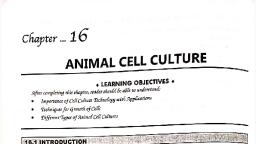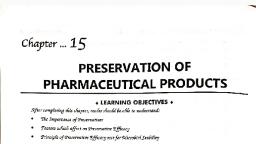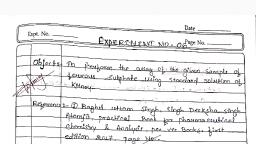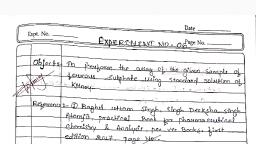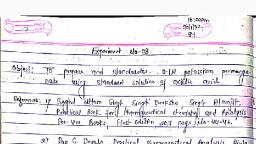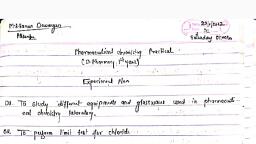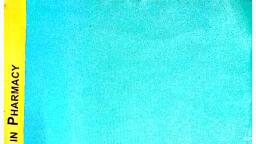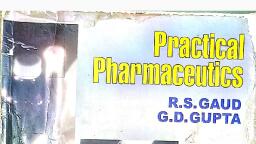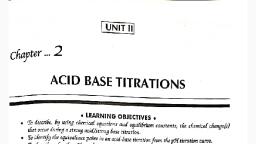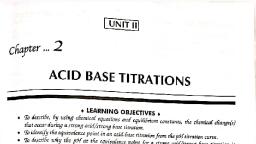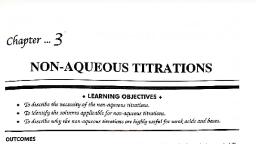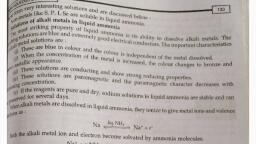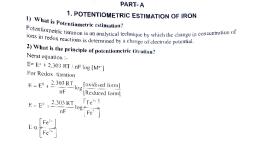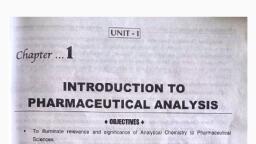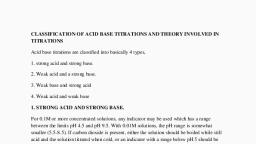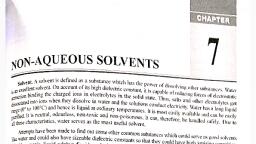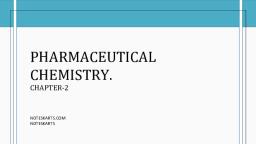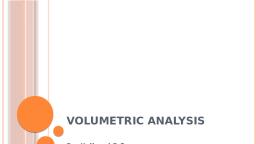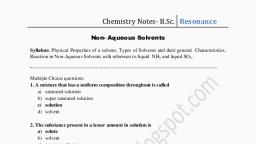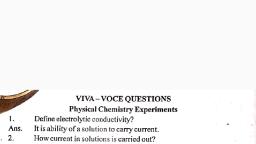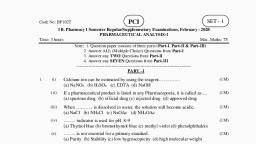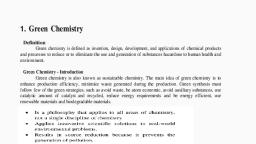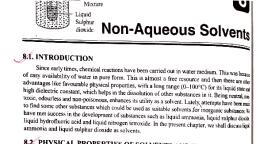Page 1 :
Chapter ... 3, NON-AQUEOUS TITRATIONS, , SSS SE ET EW 2 EI, , ¢ LEARNING OBJECTIVES +, © To describe the necessity of the non-aqueous titrations., © To identify the solvents applicable for non-aqueous titrations., © To describe why the non-aqueous titrations are highly useful for weak acids and bases., , , , , , OUTCOMES, On satisfying the requirements of this course, students will have the knowledge and skills, to:, * Requirement of non-aqueous titrations, levelling effects of solvents and nature of the, solvents., * Quantitative analysis of the weak acids and bases by non-aqueous titrations., , , , , , , , , ‘3.1 SOLVENTS., , Most of the titrations are performed in the aqueous media, means water is used as, solvent. There may be difficulty if reactant is insoluble in water or reactant is reactive with, water or the analyte (sample) is either too weak acid or too weak base., , Those too weak acids or bases can not be titrated in aqueous solution due to the, amphiprotic behaviour of water (i.e. water can react as an acid on titration with a base and, act as a base on titration with acid). So water will compete with the sample if it is weak acid, Or weak base., , The simple solution for this proble, non-aqueous solvent. So this type of titration is named “Non, Reasons for Non-aqueous Titrations:, , The reactant is insoluble in water: If t, non-aqueous solvent is mandatory to dissolve the compound., The reactant is reactive with water: If the reactant is reactive with water and converts its, , chemical composition when dissolved in water, then also non-aqueous titration method is, used,, The sample is too weak acid or too weak base: If the reactant com, Or base, then dissociation of the compound will be very less and enou, ion cannot be achieved and non-aqueous titration is preferred method., (3.1), , , , , , m is to replace water as solvent with another, -Aqueous Titration”., , he reactant compound is insoluble in water, then, , pound is very weak acid, gh concentration of the
Page 2 :
D, , 3.2 Non-Aqueous Titration,, , Pharmaceutical Analysis, ‘3.2 TYPES OF SOLVENTS IN NON-AQUEOUS T ITRATIONS, , , , , , Protogenic solvents: 4, These are acidic solvents and used to enhance the basicity of weak bases., , Examples: Glacial acetic acid. (Anhydrous acetic acid is called glacial acetic acid, it is frog, from water content and solidifies at 16.7°C)., , Protophilic solvents: ’ ‘, These are basic solvents and used to enhance the acidity of weak acids,, , Examples: Pyridine, Ethylenediamine and Dimethylformamide (DMF)., , Amphoteric solvents: . " |, These solvents behave as acid as well as base depending on the substance dissolved in it., , They can accept or donate protons., Examples: Alcohols, Ethanol, Methanol,, , Aprotic solvents: _& ., These solvents neither accept proton nor donate proton. They are used in dissolving the, , drugs especially those are insoluble in water., Examples: Benzene, Carbon tetrachloride., , Selection of solvent:, The selection of solvent in non-aqueous titration is based on:, , Solubility of drug: The weak acidic or basic drug should be soluble in the solvent which, , at the same time must be miscible with the titrant., Nature of drug: The solvent is used according to the nature of drug, whether it is weak, , acid or weak base., Unreactivity: The solvent should be unreacted with the drug., , Selected Examples of Non-Aqueous Solvents:, Many inorganic solvents are used in non-aqueous titrations, but most commonly used, , solvents are listed below:, , 4. Glacial acetic acid (CH;COOOH):, It is also known as Glacial ethanoic acid and is most commonly used non-aqueous, , solvent. Before using glacial acetic acid, water content should be checked and permitted, , within the range of 0.1% and 1.0%., , 2. Acetonitrile (CH3CN):, It is used with other solvents (chloroform, acetic acid) and enables sharp end points to be,, |, , obtained in the titration of metal ethanoates when titrated against perchloric acid., , 3. Alcohols (CH3;OH, C2HsOH, C3H7OH, CyHyOH, HOCH2CH2OH):, Methanol, ethanol, propanol, butanol and ethylene glycols are used as solvents for both, , polar and non-polar reactants in non-aqueous titration, All the solvents should be free from, , water content., 4. Dioxane: 0., Dioxane is also used in non-aqueous titration as a replacement C ), oO, °, , of glacial acetic acid. Dioxane is not a levelling solvent., HOA yet, , 5. Dimethyiformamid (DMF):, DMF is a protophillic solvent and commonly used for titration, , of amides and benzoic acid in non-aqueous titrations., CH,
Page 3 :
3.3 Non-Aqueous Titrations, , , , , , ag SLING EF s ears ane, (4.3 -ctY of weak acids can be enhanced in presence of a basic solvent. This is because, , The thas @ higher affinity to take up protons from the acid. So acetic acid behaves as, pier in ammonia solution (basic solvent). Also the basicity of weak bases can be, 4 trond in presence of acidic solvent. This is called the levelling effect of the solvent. By, etene concept, the strength of weak acidic or weak basic drugs can be enhanced by, using OT in the appropriate solvent to enhance its strength and then can be titrated by, , , , ae titration (non-aqueous titration)., acid” ‘, reveling Effect Reactions:, Hcl —> H* +c, Q=, H;SO, —> 2H" + SO, All acts as strong acid in water and all, HNO; —> H* + NO3 are actually strong acids., , HClO, —> H* + ClO,, Ifwe are taking the example of weak acid; then, 2- + 2. @:, 04H, —> (COO). + 2H" + C:04H, (Remaining because of, incomplete dissociation; when water is used as a solvent)., Now ammonia is used as a solvent; then, , HCl + NH; —> NH, + Cr, + 2H2SO4 + 2NH3 —> 2NHg + SO, Again all strong acids act as strong, HNOs + NH; —> NH + NO3 acid in ammonia, HClO, + NH3 —> NH, + ClO,, , and C,OgHp + 2NHs —> (COO) + 2NH; (Weak acid will be completely, dissociated and acts as strong acid due to leveling effect)., ef oe should be avoided in non-aqueous titration to increase the sharpness of the, ome also temperature should be kept constant during titration due to higher, a of expansion of organic solvents., aera ariating Solvents: Degree of dissociation varies for different acids or bases in, i iating solvents; means these types of solvents do not gives levelling effect., i cae A strong acid acts as a levelling solvent for bases, but a weak acid acts as a, applicable ‘on solvent for the acids, because complete dissociation not occurs. Same rule is, erenti Or strong basic and weak basic solvents., ntial Effect Reactions:, , HCl —> H* + cr, HBr —> Ht + Br All acts as strong acid in water and, HI —» Ht +r all are actually strong acids.
Page 4 :
Pharmaceutical Analysis as Non-Aqueous Titration, , If glacial acetic acid is used as a solvent; then HI will be strongest acid, HBr will be, moderate and HCI will be weakest acid amongst all three; and this effect is known as, differential effect., , (3.4ACIDIMETRY.AND ALKALIMETRY: TITRATION Acidimetry:, , It involves the quantitative determination of weak bases by non-aqueous titration., Alkalimetry;, , Itinvolves the quantitative determination of weak acids by non-aqueous titration,, , , , , , , , , , , , , , Details Acidimetry Alkalimetry, Samples: Basic drugs such as: Ephedrine, | Acidic drugs such as: Nalidixic acid,, Adrenaline, Caffeine, Acyclovir, Flurouracil., Solvent: Protogenic solvents such as: glacial Protophilic solvents such as: OMF, acetic acid, Titrant: Perchloric acid HClO, Sodium methoxide., , , , , , , , Indicator: | Crystal violet (0.5% in glacial acetic | Thymol blue (0.5% in methanol), , acid) Colour change from violet to | Colour change from pink to blue., yellowish green., , , , , , , , , , , , , , , , i3.5 INDICATORS 2 : Cae, The ionized and non-ionized indicators are used for non-aqueous titrations, but colou, changes during the end point vary for different titration, because it is dependent on the, , nature of the titrant. The resultant colour at the correct end point can be determined by, , carrying out a potentiometric titration and at the same time observing the colour change, of the indicator., , List of commonly used indicators in non-aqueous titrations are given below:, 1. Crystal Violet (0.5% w/v solution in glacial acetic acid), , HCw CH,, , O, oy Oa, , HW, |, CH, 3
Page 5 :
Pharmaceutical Analysis 3.5 Non-Aqueous Titrations, , Colour change: Violet through blue followed by green, then to greenish yellow, in, reactions in which bases such as pyridine are titrated with perchloric acid., 2. Methyl Red (0.2% w/v solution in dioxane), , mK J, Hew CooH, I, , CH;, Colour change: Yellow (Alkaline medium) to red (Acidic medium) colour., 3. Naphthol Benzein (0.2% w/v solution in glacial acetic acid), , 9, |, , 1 ‘A O, , Colour change: Yellow (Alkaline medium) to green (Acidic medium) colour change. It, , gives sharp end points in nitro methane containing acetic anhydride for titration of weak, bases against HCIO,., , 4. Quenaldine Red (0.1% w/v solution in ethanol), , Sy, Cy \7NZ @, CH,, Mee w, CH,, Colour change: Purple red (Acidic medium) to pale green (Alkaline medium)., 5. Thymol Blue (0.2% w/v solution in methanol), , ° CH;, , Uy, HC’ |, , CH,, 9, u, Nao~ ty, ‘OH, , HC CH,

